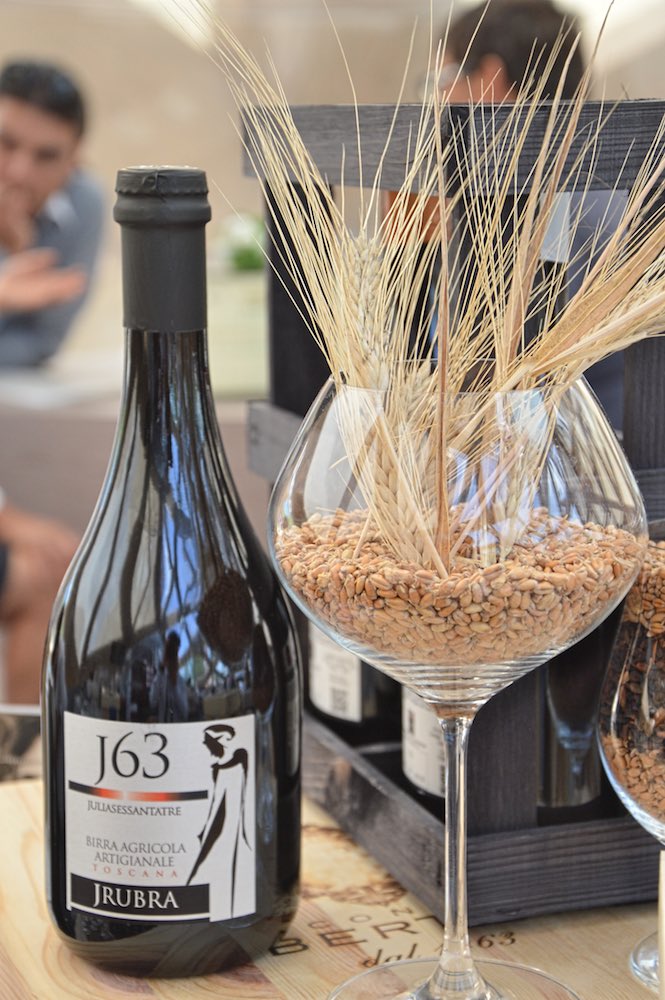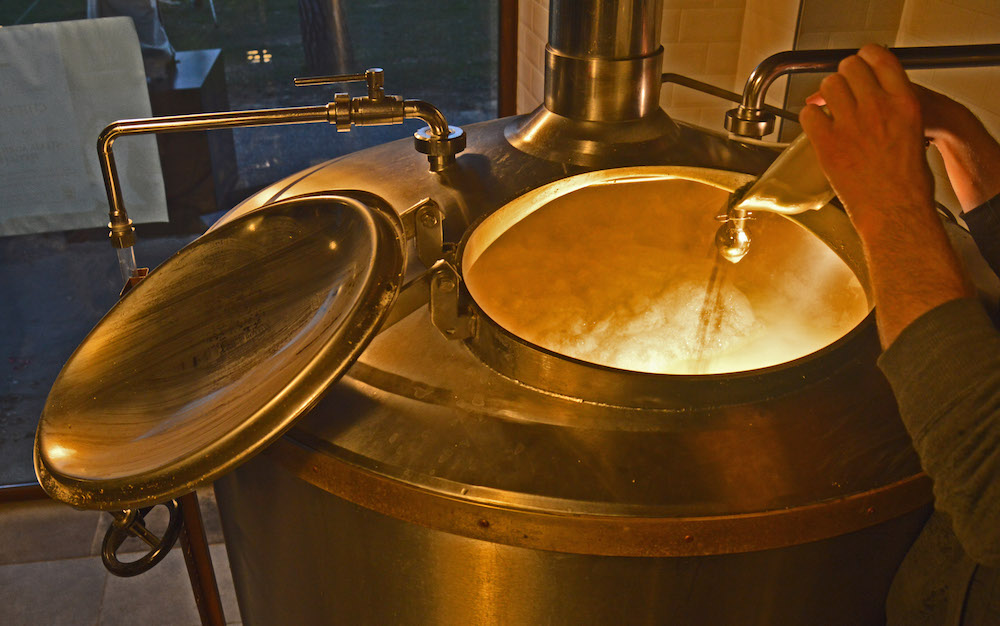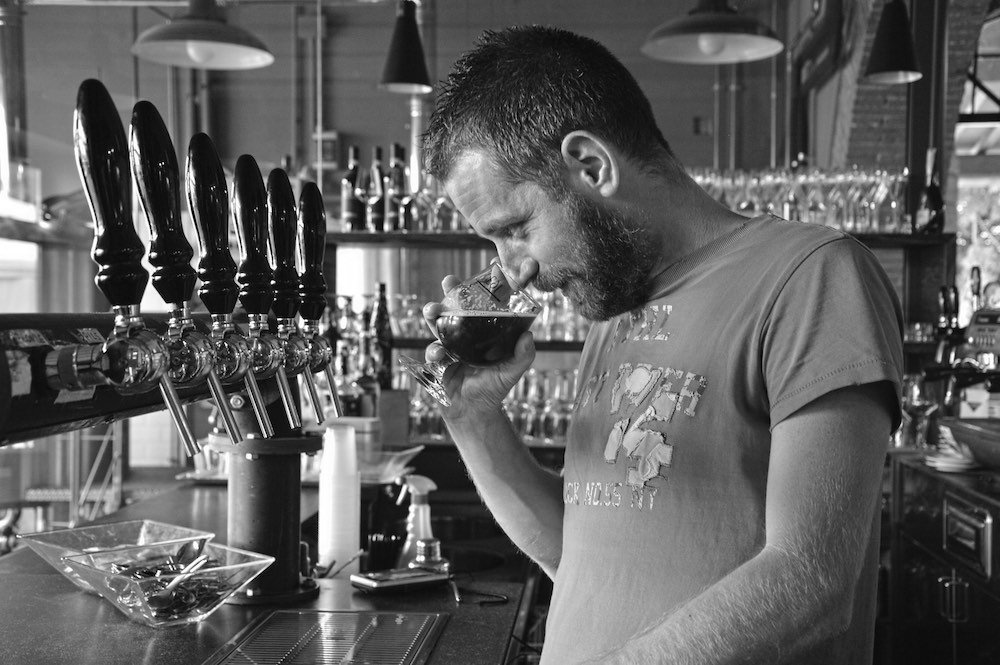Obtained from an old farmhouse within the estate Tenuta Agricola Torre a Cenaia, the Birrificio Agricolo Artigianale J63 cultivates independently the barley necessary for the realization of beer. After harvest, the cereal is sent to the consortium to obtain malt and from there sent back to the Brewery, where the work starts. J63 is part of COBI, Italian Consortium of Barley and Beer Producers and can show the certificated trademark of AGRICULTURAL BEER, issued by the Ministry of Agriculture and Forestry and indicated in the back label of each bottle
As you know, brewing is a complex and detailed process of several stages:
MALTING PROCESS
To begin, you select the raw material which is the barley, to which can be added other grains. After choosing the best beans and cleaned, they are immersed in the maceration tanks, where the germination will be stimulated thanks to the action of water, oxygen and appropriate temperature. Here barley stays for three or four days, immersed in water which is constantly renewed and maintained at a temperature of about 12-15 ° C. The grain so absorbs the necessary moisture and the outer layer of bran softens: it is time to transfer the barley in the germination caissons, in a ventilated place. After about a week the sprout comes out from grain: when it has reached a length of about 2/3 of this, the process is interrupted by drying or torrefaction

GRINDING
At this point, the raw material is ready and the brewing can begin. But first we must prepare malt through the grind. Malt is crushed and broken in the mill. The result is a kind of flour, a mush which still retains the coarse pieces, more dense than a powder and which can finally be poured into the cooking tanks.
MASHING
The toasted barley is now poured into the vat of the mixture and filtration, also said mash tune, containing warm water that is gradually heated to a temperature of about 60 ° C. The relationship between water and malt is of 3: 1, 3 liters of water for one kg of raw material. In these conditions begins the mash determined by a series of enzymatic reactions: the starch contained in the malt is transformed into maltose, also called malt sugar. The compound is constantly mixed and brought, with gradual step, to the optimum temperature to allow the enzymes to degrade starch and proteins and so favor the solubilization of proteins in the mash; this process is called proteases. Proteins are the “bricks” of beer foam, which make it more dense and compact. The steps of the mash at different temperature levels, are decided by the brewer according to the type of beer to be produced, and each lasts about 20 minutes. The last phase is called mash out and reaches a temperature of 78 ° C: this is where the alfaminasi happens, that is the time when the attack of enzymes to the starch becomes stronger and produce dextrin or non-fermentable sugars , which will remain as residues in beer.
THRESHING
Finished mash, the wort is purified from the insoluble component, what in the jargon is called spent grain. This is a residues storage consisting of the outer casings of shredded malt grain. They still contain a high amount of nutritional principles that have not undergone the solubilization and for this they can be used in livestock breeding and also in the kitchen, for example, to enrich the dough of pizza and focaccia.
COOKING AND HOPPING
The purified liquid must is now ready to be boiled. It is then transferred to the kettle, where it is boiled for about ninety minutes: this is the moment in which the excess proteins coagulate and we are witnessing the concentration and sterilization of the must. And now another key ingredient is added, hops: you use various types, depending on the type of beer and they are inserted in precise moments of boiling – they all derive exclusively from the female flower of the plant. Hops are classified into two broad categories: bittering hops and aroma hops, which are added to the must in this order, first the bitter and then the aroma. In this phase you go to determine the classic bitter taste of the beer and its unique scent: each type will have its degree of bitterness and its aromas, expertly blended by the skill of the brewer to get the desired combination. During the boiling, through reactions between the polyphenols of malt and hops and malt proteins, they are formed insoluble complexes that constitute the so-called trub. At the end of this phase you go to separate this precipitated solid by centrifuging the whole: it is the moment of the whirlpool, which lasts approximately 20 minutes. The ‘dirt’ of the must is concentrated at the center of the compacted boiler and through the lateral holes comes out the ‘clean’ must that through the pipes will reach the fermenters. But first, passing through a plate heat tank, the wort is cooled; here then again the road to the fermentation tank.

FERMENTATION
After reaching a temperature ranging between 10 and 20 ° C depending on the type of beer, which for this will be called high or low fermentation, the must thus enters in the fermenters. Here they are added the specific yeast for the type of beer that we will produce and which will go to work in aerobiosis conditions, in the presence of oxygen. The true and proper fermentation begins now and consists of two stages: the primary and the secondary, this latter also called maturation. During the main fermentation, yeasts convert the sugars and amino acids in alcohol, carbon dioxide and aromatic substances. The yeasts used are divided into two major groups:
the first is that of low fermentation and which includes the yeasts of the Saccharomyces Carlsbergensis family. These yeasts operate at a temperature between about 5 ° C and 10 ° C; at higher values they could give the beer a nasty taste. Lagers are produced from these yeasts; the second is that of high fermentation.
These include yeasts of the Saccharomyces cerevisiae family, working between a temperature of 15 ° C and a 23 ° C approximately. They are used for the production of so-called ales: thanks to the higher temperature, the fermentation of ales is faster compared to the lager, just three or four days. At the end of this process the spent yeast rises to the surface.
MATURATION
After the stage of the primary fermentation you pass to the secondary fermentation: the ‘young’ beer is transferred into the ripeners, large vats usually made of steel, which are maintained at the temperature between 0 ° C and 2 ° C for four or five weeks. In this phase it is necessary to prevent oxygen oxides the beer, for this the containers are saturated with carbon dioxide. In the maturation containers it takes place the process of clarification of the beer, which after fermentation is cloudy and ‘dirty’: the last remnants yeast precipitate and the liquid becomes clear. Now the beer stabilizes and reaches a balance of flavors and the desired taste.

FINAL STAGES
In an industrial process now it would be the time to move to the pasteurization and, subsequently, to the filtration. The industrial beers are brought to a temperature of about 60 ° C to eliminate the present micro-organisms and to allow a longer shelf life. But this is not the case for craft beers so-called raw, among which the J63 agricultural beers produced in Torre a Cenaia. Low fermentation craft beers at this point can go directly from the ripening apparatus to the bottle filling machine. The high fermentation beers are instead transferred to the priming, a smaller tank where sugars and yeasts are added in order to prepare the beer to the second fermentation, which will take place in the bottle or keg for about 15-20 days at a controlled temperature of 20 -22 ° C. Here is that even the ales are ready to be bottled. But before you can enjoy it, it is good to wait a month or so to let ripen completely bottled beer. Only after this further period of aging, the beer will be ready to unveil the most of its organoleptic characteristics.
Everything on the right times … Prosit!


